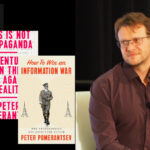
In this third episode of War Room’s special series on Great Strategists, Larry Goodson presents the writings of Kautilya, who is lesser known to military audiences that Clausewitz or Sun Tzu. As counsel to a young emporer in 4th century BCE India, Kautilya developed and published the earliest known works explaining the international relations philosophy known today as realism. ‘Conquer or be conquered’ and ‘the friend of my enemy is my enemy’ are among the teachings originating from the Arthashastra, a collection of 14 books that covered matters of both military and civilian governance.
[Kautilya] is considered the first great political realist. Most international relations scholars treat [his Arthashastra] as a treatise of unvarnished realism.
Podcast: Download
Subscribe: Apple Podcasts | Spotify | Amazon Music | Android | Pandora | iHeartRadio | Blubrry | Podchaser | Podcast Index | TuneIn | Deezer | Youtube Music | RSS | Subscribe to A Better Peace: The War Room Podcast
Larry Goodson is Professor of Middle East Studies at the U.S. Army War College. Jacqueline E. Whitt is Professor of Strategy at the U.S. Army War College. The views expressed in the podcast are those of the podcasters and do not necessarily reflect those of the U.S. Army War College, U.S. Army, or the Department of Defense.
Photo credit: NARINDER NANU/AFP/Getty Images
Posts in the “Great Strategists” series:
- ON CARL VON CLAUSEWITZ (EPISODE 1)
(GREAT STRATEGISTS) - SUN TZU AND THE ART OF WAR (EPISODE 2)
(GREAT STRATEGISTS) - MAHAN AND SEA POWER (EPISODE 4)
(GREAT STRATEGISTS) - THREE PIONEERS OF AIRPOWER
(GREAT STRATEGISTS) - JOHN BOYD AND THE “OODA” LOOP
(GREAT STRATEGISTS) - JOHN WARDEN AND THE ENEMY AS A SYSTEM
(GREAT STRATEGISTS) - BEYOND THUCYDIDES: HERODOTUS, XENOPHON & UNDERSTANDING WAR
(GREAT STRATEGISTS) - THE NATURE AND CHARACTER OF WAR — THUCYDIDES
(GREAT STRATEGISTS) - A SCIENTIFIC APPROACH TO WAR? ANTOINE-HENRI JOMINI
(GREAT STRATEGISTS) - HOW MUCH FOR THE PEN? SCHELLING
(GREAT STRATEGISTS)




I have become an enthusiastic admirer of Dr. Larry Goodson’s scholarship and teaching. As a student at the U.S. Army War College, his instruction opened an entirely new intellectual doorway for me. He was the one who first introduced me to Kautilya in any deep sense. Through his guidance I discovered the depth, rigor, and enduring relevance of this ancient political realist. Dr. Goodson’s ability to connect classical statecraft with modern strategic thought broadened my professional horizon and inspired me to pursue a deeper study of Kautilya’s insights into power, leadership, and governance. His influence continues to shape the trajectory of my strategic education, which has only increased my appreciation for the realistic strategic thinkers who anchor it.